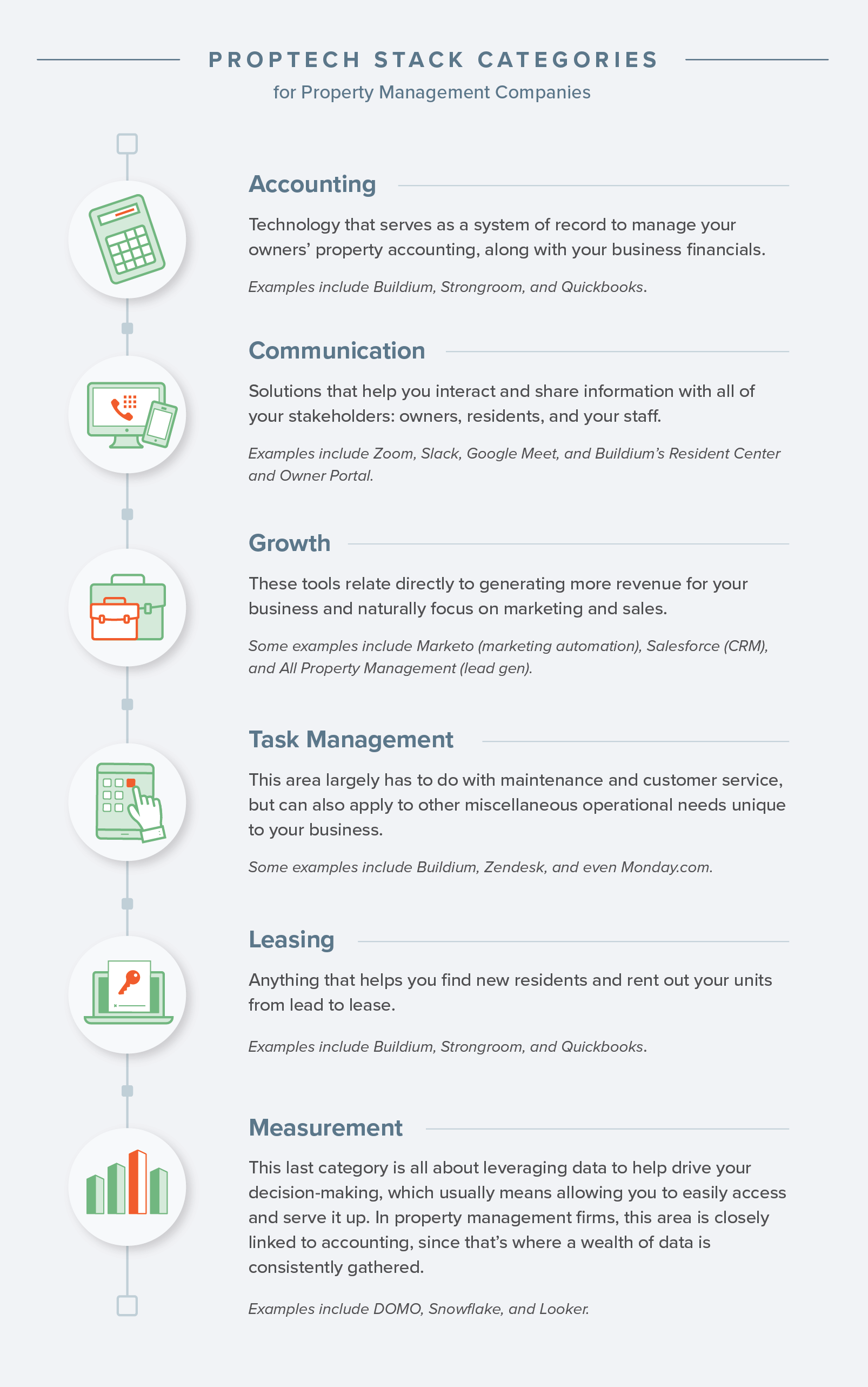Your technology and your property management business are inseparable. And the sum total of the software you use forms an ecosystem (or tech stack) that needs to be tweaked and nurtured regularly. You know that the experience that you create with technology is increasingly important as consumers rely on what’s virtual first; and that it’s up to you how well all the individual pieces work together.
Chart of Accounts
Want clearer, cleaner books? What about a more useful view into your properties or just easier accounting in general?
Get the GuideDone right, a good tech stack makes your operations smoother and still keeps your hands (and hours) free to invest in the human-to-human interactions. Done wrong, though, and you can wind up with a collection of disparate solutions that don’t suit your business’ needs and fail to deliver a sustainable ROI.
And it’s not getting any less complex for business owners: just take one look at the latest Martech 5000 supergraphic that visually illustrates the complexity and breadth of technology that’s out there for marketers.
In this piece—to make your technology choices easier to digest—we’ll dive into what a proptech stack is, and what to look for in a solid property management tech stack; and also share insights from experts who are passionate about constantly making their technology work better.
What Is a Proptech Stack?
Proptech, first off, is a term that originated with tech investors in the real estate space—and the slew of real estate industry startups that were born from the boom of investment in the early 2000s. Think Zillow, Trulia, Redfin, Matterport—any real estate tech company that seeks to bring traditional business models online that were previously manual and most likely inefficient.
A tech stack is all the software that you rely on to keep your core business functions running. Although it’s natural to conceptualize a stack in a rigid way, the best ones are well-rounded, open, and interconnected.
What Are the Main Categories of a Tech Stack?
In general, the major categories that we see in any property manager’s technology stack are what you would expect with most businesses, barring specific needs for property management.
The 2020 State of the Property Management Industry Report found that 79% of property managers used property management software to streamline their business operations. While this is a central hub that works its way into various categories below, there’s plenty of other technology that makes up your tech stack.

Now that both pieces are defined, we’ll jump into what to look for in a well-assembled proptech stack.
#1: Lean Towards Flexibility and Openness
Many property management companies search for the holy grail of tech, but no solution is perfect for every business. In fact, a lot of PMs create their own processes and no two businesses are exactly alike as a result.
While that might be the case, one trend that’s become more evident in the space is the movement towards added flexibility with open APIs that allow you to connect workflows and data across technology platforms. The point of this is to not only make operations more efficient, but also get at data for a more holistic view of your business’ health. RealPage began this journey with Real Page Exchange (RPX), and Buildium (a RealPage company) recently launched Open API that makes this flexibility possible in the SMB market.
According to Patrick Rubeski, VP of Engineering at Buildium, “In any industry you see a series of expansions and contractions. And your tech stack has to be resilient to that. A lot of times, you want to solve for a point in time—and that’s a fool’s errand. You have to be able to solve for those expansions and contractions.”
Check out the interview, The Future of Open Data in Proptech, with Patrick Rubeski, VP of Engineering at Buildium.
#2: Seek Access to the Data You Own
Data is currency, and anyone who has paid attention to the rise of tech goliaths Google and Zillow understands that already. Your data, used in the right way, opens up myriad opportunities to be more efficient and chase down new revenue streams. But it all starts with data that’s accessible.
In fact, according to Chiefmartec, the biggest category of growth was in the software that served up data in new ways—in fact, these data tech companies saw a 25.5% increase from 2019 to 2020.
The fact that new data-focused companies are surging means that there’s immense value in accessing and controlling your own data. Getting at that data is the first step; you have to make it a required component of your tech ecosystem.
#3: Weigh the Pros and Cons of Customization
Who wouldn’t want an all-in-one platform customized to your every need out of the box that’s also cost-effective? That just doesn’t exist. The reality is that there are tons of platforms and point solutions available, but sometimes it’s worth evaluating the pros and cons of custom development.
The idea behind all this is that workflows and integrations under one platform are the easiest to get right, maintain, and evaluate. A slew of custom tech or integrations that aren’t properly managed can create downtime when you need a process most—and you lose money and create new problems every second your operations are offline. If you want to go more custom, you need to be ready for it.
#4: Make Measurement Part of Your Culture
One element that’s essential in any tech stack is the ability to measure your performance once you have access to your data. At the end of the day, the insights that you make—by way of your technology—need to be tracked and communicated as part of your culture.
How else will you be able to weigh if an integration or software is truly worth the price? Since SaaS technology is so prevalent in today’s tech stack, this type of analysis is necessary at least once a year. If you can get to a solution that works well enough, then maybe that’s all you need, but being judicious is a trait that any entrepreneur needs to hold onto tightly.
#5: Never Stop Iterating
Technology doesn’t exist in a vacuum, and as the world changes, so do your technology options. Just in the last few years, billions of dollars have flowed into the proptech space, which means there are a lot of good options up and down the tech stack.
As proptech evolves, there will always be new solutions that come and shake things up. Flashy bells and whistles aside, the fundamentals of what technology should deliver still come down to the simplicity, flexibility, and ROI your business needs. For that reason, Matt Leschber habitually diagrams out his full tech stack on a white board, evaluates the process enhancements his team has made, and what they’ve gotten out of it.
Leschber says, “We’re gonna start with an empty dry erase board again and take our systems—chart them and plot them—and go all the way back through everything again.”
Whatever the world brings or whatever new technology appears, businesses want their tech stack to support the experiences that they aspire to create. This goes beyond your customers and, ultimately, applies to every stakeholder that’s affected by what you do in your market.
If, at any point, what you’ve put together causes you too much strife, take a hard look and break it down to its core. Understand why each piece of software is part of your chosen stack and what its purpose is to your business—scrutinize everything and look for redundancies as opportunities for efficiency. It’s what all of the technologists we talked to are always willing to do. That’s the most exciting aspect of the technology you rely on for your business each day.
Read more on Mixed Portfolio

